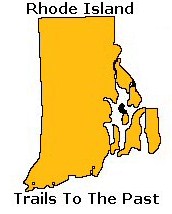|
History of Phenix
Source: The History of Washington & Kent Counties
Written by J. R. Cole published in 1889 by W. W. Preston & Co.
Undertakers.- For many years there was no regular undertaker in Phenix ; when a person died some carpenter was engaged to make a coffin. For many years Robert Levalley, of the firm of Levalley, Lanphear and Company, attended to the making of coffins; after they were made they were stained red. In 1840 James P. Arnold, in conjunction with his brother Nathaniel, made coffins in a shop standing near where the Briggs House is now, and remained there until April, 1842, and then left the place and returned in 1851, and in connection with Jonathan Tiffany opened a store and coffin shop in a store built by Thomas P. Lanphear near the Lanphear Machine Company's shop. The store is now occupied by Henry D. Eddy. Mr. Arnold remained there until April, 1852, when he commenced the undertaking business in a carpenter's shop in the rear of where Capron's bake shop now is, where he continued until the building was burned.
William B, Spencer engaged in the undertaking business in 1855, employing James P. Arnold to attend to the business, and continued furnishing the stock, employing Mr. Arnold until 1860, when he sold the business to Mr. Arnold and rented him the shop, who soon after added to his business furniture and house furnishing goods and occupied the rooms over Capron's bakery until the building was burned in 1871, when he occupied other rooms until the building was rebuilt, when he returned and remained there until the building was again burned in 1873, when he occupied a building near the bridge on the south side of the river near the railroad station until March 12,1888, when the building with all its contents was burned. Mr. Arnold then obtained rooms in Capron's building and continues the undertaking business at that place.
Railroad.-The Pawtuxet Valley Railroad was chartered January, 1869, charter amended May, 1872, again amended January, 1873, May, 1874, and May, 1875. The road was built from Hope village in Scituate, to River Point in Warwick, passing through Phenix and connecting with the New York and New England railroad at River Point. Passenger cars commenced running August 5th, 1874. The road was leased to the New York and New England Railroad Company for five years, who furnished the rolling stock. After the expiration of their lease the road was extended to Pontiac and from thence connecting with the New York, Providence and Boston Railroad at Auburn station. The road was leased to the New York, Providence and Boston Railroad Company for ninety-nine years and they run cars from Providence to Hope, which is much pleasanter for the passengers than having to change cars at River Point, as they did when the road connected with the New York and New England railroad.
Hotels.-There are two good hotels in the village of Phenix. The history of the tavern business extends back to the Atwood's, whose ancestor, Charles Atwood, bought property in Wales February 16th, 1747. In 1785 Caleb Atwood owned a house on the northwest side of the highway, which he occupied for a tavern. After the Coventry and Cranston turnpike was opened for travel he kept the toll gate and built an addition to the tavern house, and opened a grocery store and a hall in the second story. He carried on his business until his death, July 14th, 1833.
The tavern was the resort of persons who liked to imbibe the ardent freely, and sometimes got so lively they had to be ejected. In 1839 George Kenyon erected a large house on Birch Hill, in which Owen Burlingame kept tavern for a number of years. The old Atwood Hotel was torn down about the year 1845. The old chimney was torn down by William B. Spencer when he built Spencer s Hall. This old tavern stood just back of the Phenix Hotel.
November 5th, 1847, Harrison and Emanuel Collins bought of W. B. Spencer a lot of land on the corner of High and Pleasant streets, running 60 feet on High and 100 feet on Pleasant street, on which they erected a large house used for a store and hotel; Emanuel soon after sold his interest to his brother Harrison, who resided there until his death, August 6th, 1864, in the 5lst year of his age. The estate is now owned by Rhodes Andrew, and is known as the Phenix Hotel. It was destroyed in the great fire of May 24th, 1871, and rebuilt the same year.
In 1858 John Lippitt was the owner of a house where the Briggs Hotel is now located. April 11th, I860, he sold the estate to Stephen C. Briggs, who was then working in the blacksmith shop occupied by James Carroll at Lippitt. October 17th, 1860, he added another lot to his former purchase, and May 4th, 1861, another lot was purchased, and after building an addition to the house, Mr. Briggs opened it in February, 1870, as a hotel, giving up blacksmithing, as he found the hotel business more profitable than blacksmithing, and continued in that business until his death, and his son now continues it at the same place, although the former house and buildings were destroyed by fire July 13th, 1885. His son, Willet G. Briggs, has erected a fine house and barn where the former buildings stood and continues the business, and his place is known as the Briggs Hotel.
The information on Trails to
the Past © Copyright may be used in personal family history research, with source citation. The pages in entirety may not be duplicated for publication in any fashion without the permission of the owner. Commercial use of any material on this site is not permitted. Please respect the wishes of those who have contributed their time and efforts to make this free site possible.~Thank you!
|

